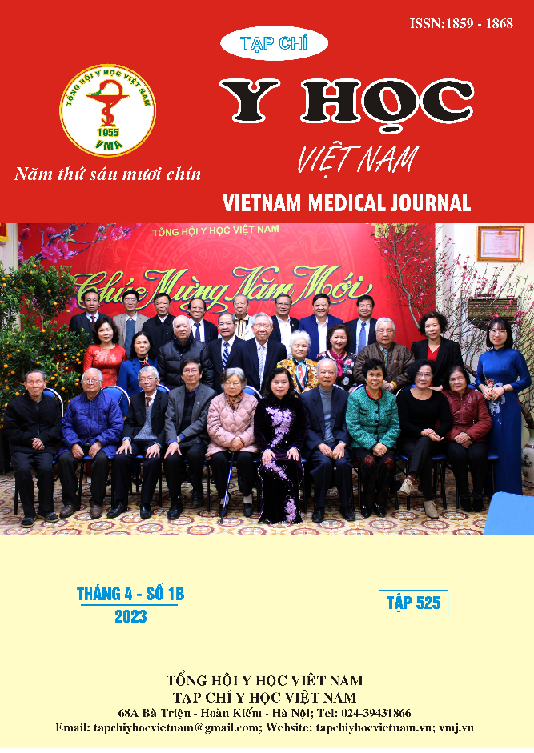EFFECT EVALUATION OF GLUE EMBOLIZATION FOR HEMOPTYSIS DUE TO SEQUELAE OF PULMONARY TUBERCULOSIS IN VIETDUC UNIVERSITY HOSPITAL
Main Article Content
Abstract
In 47 patients with pulmonary TB sequelae causing hemoptysis who underwent endovascular intervention with NBCA, there was a high clinical success rate (93.7%) with a low recurrence rate (10.3%) after 6 months follow-up. 90.4% of lesions were from the bronchial artery, followed by branches of the subclavian artery (34.6%). The NBCA:lipiodol ratio used was from 1:3 to 1:10 with the most commonly used ratio being 1:6 in 20 patients (42.6%). Complications of chest pain and dyspnea appeared in 45 patients (95.7%), nausea and vomiting in 2 patients (4.3%), 1 patient (2.1%) died after intervention due to respiratory failure by severe hemoptysis causing bronchial obstruction with bacteremia due to pneumonia, no neurological complications. Since then, it has been shown that using NCBA in the treatment of hemoptysis due to pulmonary sequelae brings good results for patients with high clinical success rate, very low recurrence rate after 6 months of treatment.
Article Details
Keywords
Hemoptysis, bronchial artery, embolization.
References
2. Remy J, Voisin C, Ribet M, et al. [Treatment, by embolization, of severe or repeated hemoptysis associated with systemic hypervascularization]. Nouv Presse Med. 1973;2(31):2060.
3. Yoon W, Kim JK, Kim YH, Chung TW, Kang HK. Bronchial and Nonbronchial Systemic Artery Embolization for Life-threatening Hemoptysis: A Comprehensive Review. RadioGraphics. 2002; 22(6):1395-1409. doi:10.1148/rg.226015180
4. Panda A, Bhalla AS, Goyal A. Bronchial artery embolization in hemoptysis: a systematic review. Diagn Interv Radiol Ank Turk. 2017;23(4):307-317. doi:10.5152/dir.2017.16454
5. Sopko DR, Smith TP. Bronchial artery embolization for hemoptysis. Semin Interv Radiol. 2011;28(1):48-62. doi:10.1055/s-0031-1273940
6. Woo S, Yoon CJ, Chung JW, et al. Bronchial artery embolization to control hemoptysis: comparison of N-butyl-2-cyanoacrylate and polyvinyl alcohol particles. Radiology. 2013; 269(2):594-602. doi:10.1148/radiol.13130046
7. Baltacioğlu F, Cimşit NC, Bostanci K, Yüksel M, Kodalli N. Transarterial microcatheter glue embolization of the bronchial artery for life-threatening hemoptysis: technical and clinical results. Eur J Radiol. 2010;73(2):380-384. doi:10.1016/j.ejrad.2008.10.017
8. Kolu M, Kurtuluş Ş, Dere O, Yurttutan N, Yıldırım IO. Embolization with more diluted glue-lipiodol in patients with massive hemoptysis: single center experience results. Eur Rev Med Pharmacol Sci. 2022;26(5):1543-1548. doi:10.26355/eurrev_202203_28219
9. Yoo DH, Yoon CJ, Kang SG, Burke CT, Lee JH, Lee CT. Bronchial and Nonbronchial Systemic Artery Embolization in Patients With Major Hemoptysis: Safety and Efficacy of N-Butyl Cyanoacrylate. Am J Roentgenol. 2011;196(2): W199-W204. doi:10.2214/AJR.10.4763
10. Lee JH, Yoon CJ, Jung YS, Choi WS, Lee C ho, Lee GM. Comparison of n-butyl-2-cyanoacrylate and polyvinyl alcohol particles for bronchial artery embolisation in primary lung cancer: a retrospective cohort study. Respir Res. 2022;23(1):257. doi:10.1186/s12931-022-02183-7


